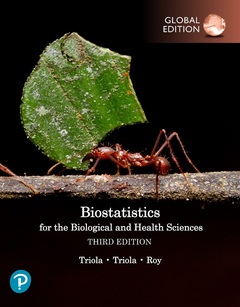Biostatistics for the Biological and Health Sciences, Global Edition (3rd Ed.)
Auteurs : Triola Mario, Triola Marc, Roy Jason

Biostatistics for the Biological and Health Sciences brings statistical theories and methods to life with real applications, emphasis on real data, and a friendly writing style. It suits a variety of students in their first statistics course and uses minimal algebra. Abundant examples and emphasis on real data help you develop skills in critical thinking, technology and communication. This collaboration from 2 biological sciences experts and the author of the #1 statistics book is an excellent introduction that is also highly readable, understandable and relevant.
The 3rd Edition incorporates the latest methods used by professional statisticians. It offers a wealth of new data sets, examples, and exercises (such as those involving clinical trials, COVID-19, biometrics, and anthropometrics) and includes features that address all recommendations included in the Guidelines for Assessment and Instruction in Statistics Education (GAISE) as recommended by the American Statistical Association.
- INTRODUCTION TO STATISTICS
- 1-1 Statistical and Critical Thinking
- 1-2 Types of Data
- 1-3 Collecting Sample Data
- 1-4 Ethics in Statistics (download only)
- EXPLORING DATA WITH TABLES AND GRAPHS
- 2-1 Frequency Distributions for Organizing and Summarizing Data
- 2-2 Histograms
- 2-3 Graphs That Enlighten and Graphs That Deceive
- 2-4 Scatterplots, Correlation, and Regression
- DESCRIBING, EXPLORING, AND COMPARING DATA
- 3-1 Measures of Center
- 3-2 Measures of Variation
- 3-3 Measures of Relative Standing and Boxplots
- PROBABILITY
- 4-1 Basic Concepts of Probability
- 4-2 Addition Rule and Multiplication Rule
- 4-3 Complements, Conditional Probability, and Bayes' Theorem
- 4-4 Risks and Odds
- 4-5 Rates of Mortality, Fertility, and Morbidity
- 4-6 Counting
- DISCRETE PROBABILITY DISTRIBUTIONS
- 5-1 Probability Distributions
- 5-2 Binomial Probability Distributions
- 5-3 Poisson Probability Distributions
- NORMAL PROBABILITY DISTRIBUTIONS
- 6-1 The Standard Normal Distribution
- 6-2 Real Applications of Normal Distributions
- 6-3 Sampling Distributions and Estimators
- 6-4 The Central Limit Theorem
- 6-5 Assessing Normality
- 6-6 Normal as Approximation to Binomial (download only)
- ESTIMATING PARAMETERS AND DETERMINING SAMPLE SIZES
- 7-1 Estimating a Population Proportion
- 7-2 Estimating a Population Mean
- 7-3 Estimating a Population Standard Deviation or Variance
- 7-4 Bootstrapping: Using Technology for Estimates
- HYPOTHESIS TESTING
- 8-1 Basics of Hypothesis Testing
- 8-2 Testing a Claim About a Proportion
- 8-3 Testing a Claim About a Mean
- 8-4 Testing a Claim About a Standard Deviation or Variance
- 8-5 Resampling: Using Technology for Hypothesis Testing
- INFERENCES FROM TWO SAMPLES
- 9-1 Two Proportions
- 9-2 Two Means: Independent Samples
- 9-3 Matched Pairs
- 9-4 Two Variances or Standard Deviations
- 9-5 Resampling: Using Technology for Inferences
- CORRELATION AND REGRESSION
- 10-1 Correlation
- 10-2 Regression
- 10-3 Prediction Intervals and Variation
- 10-4 Multiple Regression
- 10-5 Dummy Variables and Logistic Regression
- GOODNESS-OF-FIT AND CONTINGENCY TABLES
- 11-1 Goodness-of-Fit
- 11-2 Contingency Tables
- ANALYSIS OF VARIANCE
- 12-1 One-Way ANOVA
- 12-2 Two-Way ANOVA
- NONPARAMETRIC TESTS
- 13-1 Basics of Nonparametric Tests
- 13-2 Sign Test
- 13-3 Wilcoxon Signed-Ranks Test for Matched Pairs
- 13-4 Wilcoxon Rank-Sum Test for Two Independent Samples
- 13-5 Kruskal-Wallis Test for Three or More Samples
- 13-6 Rank Correlation
- SURVIVAL ANALYSIS
- 14-1 Life Tables
- 14-2 Kaplan-Meier Survival Analysis
APPENDICES
A: Tables and Formulas
B: Data Sets
C: Websites and Bibliography of Books
D: Answers to Odd-Numbered Section Exercises (and all Quick Quizzes, all Review Exercises, and all Cumulative Review Exercises)
Subject Index
Mark Triola, MD, FACP is the Associate Dean for Educational Informatics at NYU School of Medicine, the founding director of the NYU Langone Medical Center Institute for Innovations in Medical Education (IIME), and an Associate Professor of Medicine. Dr. Triola's research focuses on precision education and the use of AI tools to efficiently personalize medical education for individual learners and give new insights to their programs and coaches. His lab develops new learning technologies and AI-driven educational interventions and also works to define educationally sensitive patient and system outcomes that can be used to assess the impact of training. Dr. Triola and IIME have been funded by the National Institutes of Health, the Josiah Macy Jr. Foundation, the Department of Education, the Department of Defense, and the American Medical Association's Accelerating Change in Medical Education program.
Mario F. Triola is a Professor Emeritus of Mathematics at Dutchess Community College, where he has taught statistics for over 30 years. Marty is the author of Elementary Statistics, 14th Edition; Essentials of Statistics, 7th Edition; Elementary Statistics Using Excel, 7th Edition; and Elementary Statistics Using the TI-83/84 Plus Calculator, 5th Edition; and he is a co-author of Statistical Reasoning for Everyday Life, 5th Edition. Elementary Statistics is currently available as an International Edition, and it has been translated into several foreign languages. Marty designed the original Statdisk statistical software, and he has written several manuals and workbooks for technology supporting statistics education. He has been a speaker at many conferences and colleges.
Marty's consulting work includes the design of casino slot machines and the design of fishing rods, and he has worked with attorneys in determining probabilities in paterni
Hallmark features of this title
- Carefully selected real data: 92% of examples and 92% of exercises are based on real data.
- Margin essays illustrate uses and abuses of statistics in real, practical and interesting applications.
- Flow charts throughout simplify and clarify more complex concepts and procedures.
- Easy-to-assign exercises are graded by difficulty. Exercises that are particularly difficult or involve a new concept appear at the end of exercise sets and are marked by an asterisk for instructors' convenience.
- End-of-chapter features include chapter reviews, review exercises, From Data to Decision: Critical Thinking capstone problems, group activities, and more.
- The latest and best methods used by professional statisticians are incorporated.
Date de parution : 07-2023
Ouvrage de 784 p.
21.6x27.8 cm



